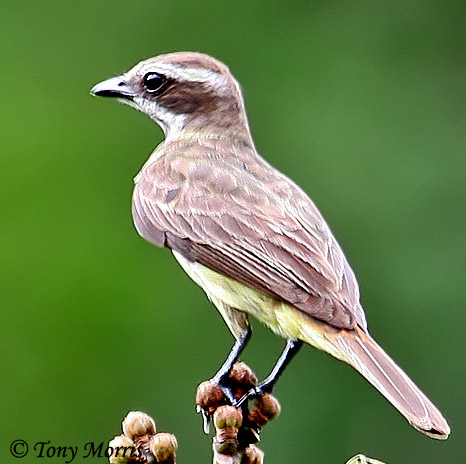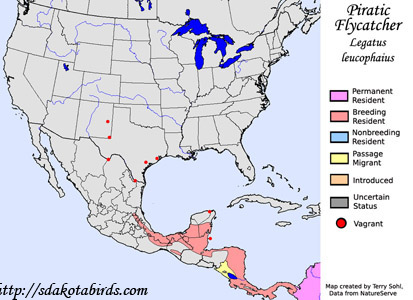Piratic Flycatcher
Legatus leucophaius
| Length: 6 inches | Wingspan: 9 inches | Seasonality: Non-resident in South Dakota |
| ID Keys: Olive-brown back, pale yellow underparts with streaking, white stripes on brownish head | ||
 The
Piratic Flycatcher is a well-named species. They don't build their own
nests, instead raiding nests of other birds, even displacing birds that are
actively nesting and destroying their eggs and/or young. They are
normally found from Mexico through South America, and are but rare vagrants
to the United States. They are mostly known from sightings in Texas
and New Mexico.
The
Piratic Flycatcher is a well-named species. They don't build their own
nests, instead raiding nests of other birds, even displacing birds that are
actively nesting and destroying their eggs and/or young. They are
normally found from Mexico through South America, and are but rare vagrants
to the United States. They are mostly known from sightings in Texas
and New Mexico.
Habitat: Found in semi-open country and open woodland, including forest clearings, forest edges, open woodland, and open areas with scattered groves of trees.
Diet: Mostly feeds on insects during the summer breeding season. Will also feed on small fruits and berries, particularly in winter.
Behavior: Forages by observing from a perch, and flying out to capture insects, either in mid-air, or by gleaning them from the vegetation surface.
Nesting: Doesn't build a nest of its own, but instead, appropriates the nest of another bird. If a nest of interest is already in use, the Piratic Flycatcher will harass the nesting birds until they leave, and will destroy any eggs and displace any young in the nest. The female Piratic Flycatcher then lays 2 or 3 eggs. She alone incubates the eggs. The young typically fledge about 18 days after hatching.
Song: Most common vocalization is a repeated whee-whee.
Migration: Breeds in Mexico, through Central America and into South America. Birds breeding in Mexico and Central America migrate to South America for the winter.
Interactive eBird map: Click here to access an interactive eBird map of Piratic Flycatcher sightings
Similar Species: For birds potentially encountered in the United States, most similar with the Sulphur-bellied Flycatcher.
Conservation Status: Overall populations may be decreasing, but they are still found over a wide geographic area and are relatively common in parts of their range. The IUCN lists the Piratic Flycatcher as a species of "Least Concern".
Further Information: 1) BirdLife International - Piratic Flycatcher
2) Audubon - Piratic Flycatcher
3) Whatbird - Piratic Flycatcher
Photo Information: Photo taken by Tony Morris - February 21st, 2011 - Bolivar, Venezuela - Photo licensed under Creative Commons Attribution NonCommercial 2.0 Generic License.
| Click below for a higher-resolution map |
 |
| South Dakota Status: Non-resident in South Dakota |
Additional Piratic Flycatcher Photos (coming soon!!)
